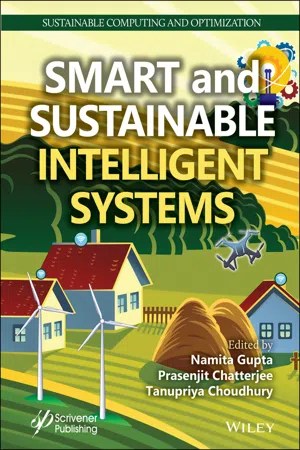
Smart and Sustainable Intelligent Systems
- English
- ePUB (mobile friendly)
- Available on iOS & Android
Smart and Sustainable Intelligent Systems
About This Book
The world is experiencing an unprecedented period of change and growth through all the electronic and technilogical developments and everyone on the planet has been impacted. What was once 'science fiction', today it is a reality.
This book explores the world of many of once unthinkable advancements by explaining current technologies in great detail. Each chapter focuses on a different aspect - Machine Vision, Pattern Analysis and Image Processing - Advanced Trends in Computational Intelligence and Data Analytics - Futuristic Communication Technologies - Disruptive Technologies for Future Sustainability. The chapters include the list of topics that spans all the areas of smart intelligent systems and computing such as: Data Mining with Soft Computing, Evolutionary Computing, Quantum Computing, Expert Systems, Next Generation Communication, Blockchain and Trust Management, Intelligent Biometrics, Multi-Valued Logical Systems, Cloud Computing and security etc. An extensive list of bibliographic references at the end of each chapter guides the reader to probe further into application area of interest to him/her.
Frequently asked questions
Information
Part 1
MACHINE LEARNING AND ITS APPLICATION
1
Single Image Super-Resolution Using GANs for High-Upscaling Factors
1.1 Introduction

1.2 Methodology
1.2.1 Architecture Details
- 1. Generator Architecture: The task of Single Image Super Resolution involves providing only a Single Low-Resolution Image (denoted by ILR) and generating a High-Resolution image output (denoted as IOHR). In the following work, we describe a GANs generator network which helps to obtain photo-realistic features in IOHR which is very identical to the Ground Truth High-Resolution Image (denoted as IGHR). The previous work on super resolution task involves SRGAN [9], which has a very good Generator and Discriminator network architecture. Some works on SRGAN modified the Residual Block Architecture to get better building block for the Generator of SRGAN like in Ref. [10].The architecture shown in Figure 1.2 is a representation of how ILR can be converted to High Resolution Image by a factor of 8×.The network consists of a Input layer which ...
Table of contents
- Cover
- Table of Contents
- Title Page
- Copyright
- Dedication
- Preface
- Acknowledgement
- Part 1: MACHINE LEARNING AND ITS APPLICATION
- Part 2: DEEP LEARNING AND ITS APPLICATION
- Part 3: SECURITY AND BLOCKCHAIN
- Part 4: COMMUNICATION AND NETWORKS
- Part 5: LATEST TRENDS IN SUSTAINABLE COMPUTING TECHNIQUES
- Index
- End User License Agreement